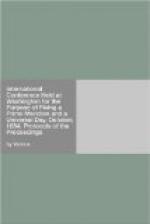No objection being made to the proposition of the President, Professor NEWCOMB arose and said:
That in reference to the remarks of the distinguished Delegate of France, Professor JANSSEN, he would prefer, if the Conference would consent, to study his arguments more carefully when they should be in print.
He remarked that some points raised by that argument have been already replied to, and he wished now more particularly to request that Professor JANSSEN would define precisely what he meant by “a neutral meridian;” that he had partially answered this question in reply to Professor ABEE; but that there was a more fundamental point, one of practice, which must be brought in and kept in mind at every step, and which was raised by Commander SAMPSON’S paper, to which he had listened with great interest. Commander SAMPSON held that it would be necessary to have a fixed observatory on the chosen prime meridian, but he (Professor NEWCOMB) did not concur in that view, but rather agreed to a limited extent with what Professor JANSSEN had said on that question.
In choosing a meridian from which to count longitude, you meet a difficult problem. You have a point on the globe defined as the first meridian. This would be taken as the initial point of departure, and you are to determine the longitude of a certain place from that point. Now, doubtless, there is no other way to do this than to have an astronomical instrument and telegraphic communication. And if they chose the Azores or Behring’s Strait, in neither case could they mount a transit instrument or have a system of telegraphic communication. Nor could we make a determination of longitude from a single fixed observatory in any case.
He then stated that it was impracticable under any circumstances to have an absolutely neutral prime meridian; that the definition of the prime meridian must practically depend upon subsidiary considerations, no matter where it might be located. In the practical work of determining longitudes a connection with the prime meridian cannot be made in each case. What is really determined is the longitude from some intermediate point, generally in the same country, and in telegraphic communication with the place whose longitude we wish to know. This intermediate point would, for the time, be the practical prime meridian. But the longitude of this point itself must always be uncertain. Science is continually advancing in accuracy, and we find that we continually need to correct the longitude of our intermediate meridian, and hence of all points determined from it. How can this difficulty of constantly changing longitudes be avoided? He replied that each system of connected longitudes must rest upon its own basis. It must be referred to an assumed prime meridian, and the measurements must be made from that, even if it be found to be somewhat in error. If some such system had been adopted thirty or forty years ago, we would have avoided




